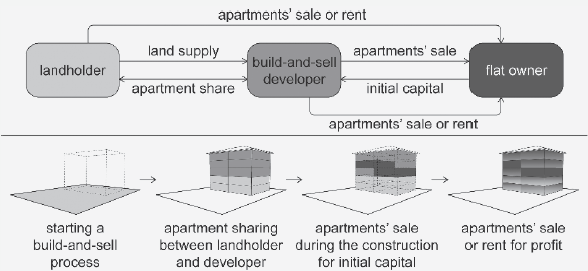Abide Sitesi as Innovative Approach to Build-and-Sell Housing Production in Post-World War II Istanbul
DOI:
https://doi.org/10.31522/p.32.2(68).10Keywords:
Abide Sitesi , Build-and-sell, Housing in Istanbul, Housing production, Mass housingAbstract
Yapsatçılık, meaning build-and-sell, is a capital-free model based on apartment sharing between landholders and developers that became widespread among the post-war housing production methods in Turkey. The Abide Sitesi settlement in Istanbul’s Mecidiyeköy district is the focus of this study, as it is the first large-scale initiative of the build-and sell method and, contrary to all criticism, proves that the method could produce successful practices. Prior to this, Kemal Ahmet Aru prepared a garden-city master plan for the same land in 1955, but this plan was never realized. After various legal regulations made it possible to open this land for settlement, in 1975, Yaşat Inc. started the Abide Sitesi project. This study examines the transformation effects of urban development dynamics on the built environment through the Abide Sitesi case. In this context, Abide Sitesi offers an in-depth analysis of project-to-construction processes, housing sale policies, and architectural characteristics. The study benefits from municipal and newspaper archives, and the theoretical framework is supported by site analysis and photographic documentation.
References
Arman, D. (1985) ‘540 bin dolara büro [An office for 540 thousand dollars]’, Milliyet, 10 December, p. 4 (Article in Turkish).
Aru, K.A. (1955) The master plan report of Mecidiyeköy Milli Re land. [Report] Istanbul Metropolitan Municipality Archives, 302. Istanbul.
Aru, K.A. and Gorbon, R. (1952) ‘Levend mahallesi: 1. kısım inşaatı [Construction of the first phase of Levent Neighborhood]’, Arkitekt, 253-254, pp. 174-181.
Balcı Öztürk, Ö. (2022) Brutal aesthetics effects in post-war Turkey: experimental interior spaces. In: 17th International Docomomo Conference. Valencia: Docomomo International and Tirant Lo Blanch, pp. 213-221.
Bilsel, F.C. (2015) ‘Geç Osmanlı döneminden Cumhuriyet’e çağdaş şehir düşüncesi ve İstanbul planlaması [The idea of the modern city and planning of Istanbul from the late Ottoman period to the Republic]. In: Yılmaz, C. (ed.) Antik Çağdan XXI. Yüzyıla Büyük İstanbul Tarihi, v. VIII. Istanbul: Kültür A.Ş. Yayınları, pp. 485-496 .
Çinici, A. and Çinici, B. (1975) 1961-1970 architectural works. Ankara: Ajans-Türk.
Ekimci, B. (2000). ‘ABD’ye villa turu [Villa tour to the USA]’, Milliyet, 14 May, p. 20.
Ekincioğlu, M. (2001) Behruz Çinici. İstanbul: Boyut Yayın.
Erbaş, A.E. (2018) ‘İstanbul metropoliten alanında 1980 sonrası kentsel gelişme dinamikleri ve idari coğrafyada sınır değişiklikleri [Urban development dynamics in Istanbul metropolitan area after 1980s and local boundary changes in the administrative geography]’, Journal of Mehmet Akif Ersoy University Economics and Administrative Sciences Faculty, 5(1) [online]. Available at: https://doi.org/10.30798/makuiibf.356757 [Accessed: 8 August 2024].
Erdim, B. (2020) Landed internationals. Austin, TX: University of Texas Press. Available at: https://doi.org/10.7560/321218 [Accessed: 28 July 2024].
Eryıldız, S. (1995) ‘Konut sorunu ve toplu konut çözümleri [Housing problem and mass housing solutions]’, Mimarlık, 261, pp. 18-36.
Güngör, H. (1984) ‘1963’ten bu yana Mimarlık [Mimarlık since 1963]’, Mimarlık, 200, pp. 18-33.
Güzer, C.A. (1995) ‘Konut sorunu sorunu [Problem of housing problem]’, Mimarlık, 262, pp. 20-21.
‘Halk Konutları Standartları’ (1964) T.C. Resmi Gazete, 24 March, 11664, pp. 6-11.
Hasol, D. (2017) 20. Yüzyıl Türkiye mimarlığı. Istanbul: Yem Yayın.
Işık, O. (1991) The penetration of capitalism into housing production: speculative housebuilding in Turkey, 1950-1980. Ph.D. dissertation. University College London.
Işık, O. (1995) ‘Yapsatçılığın yazılmamış tarihi: Türkiye’de konut kesiminde küçük üreticiliğin varlık koşulları ve gelişimi üzerine gözlemler [Unwritten history of build-and-sell: observations on the conditions of existence and evolution of small developers in the housing sector in Turkey]’, Mimarlık, 261, pp. 43-45.
Kalfa, K. (2021) ‘Giving to the world a demonstration: U.S. housing aid to Greece 1947-51’, Journal of the Society of Architectural Historians, 80(3), pp. 304-320. Available at: https://doi.org/10.1525/jsah.2021.80.3.304 [Accessed: 19 July 2024].
Kalfa, K. and Theodosis, L. (2022) ‘Dealing with the commonplace: Constantinos A. Doxiadis and the Zygos Technical Company’, ABE Journal, 20 [online]. Available at: https://doi.org/10.4000/abe.13699 [Accessed: 23 July 2024].
Karataş, S. (2022) ‘From Marshall Plan to “Hilton in wild”: the transnational history of a cooperative housing block in Esat, Ankara’, ABE Journal, 20 [online]. Available at: https://doi.org/10.4000/abe.13254 [Accessed: 12 July 2024].
Kortan, E. (1997) 1950’ler kuşağı mimarlık antolojisi. İstanbul: Yem Yayın.
Kuban, D. (1968) ‘Gelecek açısından günümüz mimari ve şehircilik uygulamalarının eleştirisi [Criticism of today’s architectural and urbanism practices in terms of the future]’, Mimarlık, 57, pp. 13-20.
Kuban, D. (1996) İstanbul: bir kent tarihi. Istanbul: Tarih Vakfı Yayınları.
Kuru, O. N. and Ek, F. İ. (2021) ‘Examination of prestigious mass-housing Identity via the Slogans: cases in Izmir, Turkey’, ICONARP, 9(2), pp. 919-942. Available at: https://doi.org/10.15320/ICONARP.2021.186 [Accessed: 23 April 2024].
Özdemir Sarı, Ö.B. (2019) ‘Redefining the housing challenges in Turkey: an urban planning perspective’. In: Özdemir Sarı, Ö.B.; Özdemir, S., and Uzun, N. (eds.) Urban and regional planning in Turkey, Urban Book Series. Switzerland: Springer, Cham, pp. 167-184. https://doi.org/10.1007/978-3-030-05773-2_9
Resuloglu, C. (2018) ‘A different experience in the build-sell process: casae study Ankara’, Open House International, 43(4), pp. 65-79. Available at: https://doi.org/10.1108/OHI-04-2018-B0008 [Accessed: 12 April 2024].
Ruhi Sipahioğlu, I. (2020) ‘A hidden node in the build-and-sell system: estate agents’, Idealkent, 11(3) [online]. Available at: https://doi.org/10.31198/idealkent.655462 [Accessed: 29 April 2024].
Salman, Y. (2019) ‘Koşuyolu: İstanbul’da bir modern mahalle [Koşuyolu: A modern neighbourhood in Istanbul]’, Dosya, 43, pp. 164-173.
Sey, Y. (1984) ‘To house the new citizens: housing policies and mass housing’. In: Holod, R. and Evin, A. (eds.) Modern Turkish architecture. Philadelphia: University of Pennsylvania Press, pp. 153-177.
Shing, T.H.; Keong Ng, E.K. and Chun, P.H. (2012) ‘Real option framework under build then sell (bts) system’, Procedia Economics and Finance, 2, pp. 383-392. Available at: https://doi.org/10.1016/S2212-5671(12)00100-1 [Accessed: 18 May 2024].
Skidmore, L.; Owings, N. and Merrill, J. (1951) Construction, town planning and housing in Turkey. New York: Skidmore, Owings and Merrill.
Şahin, P. and Şener, S.M. (2021) ‘A review on changing housing approaches and media contents in Turkey: 1930-1980 period’, ITU A|Z, 18(2), pp. 429-441. Available at: https://doi.org/doi:%2010.5505/itujfa.2021.38243 [Accessed: 21 May 2024].
Tanyeli, U. and Yücel, A. (2007) Turgut Cansever düşünce adamı ve mimar. İstanbul: Ofset Yapımevi.
Tapan, M. (1996) ‘Mass housing and its development in Turkey’. In: Abbasoğlu, H.; Tanyeli, U. and Tapan, M. (eds.) Housing and settlement in Anatolia: a historical perspective. Istanbul: Tarih Vakfı Yurt Yayınları, pp. 366-378.
Tapan, M. (1998) ‘İstanbul’un kentsel planlamasının tarihsel gelişimi ve planlama eylemleri’. In: Sey, Y. (ed.) 75 yılda değişen kent ve mimarlık. Istanbul: Tarih Vakfı Yurt Yayınları, pp. 75-88.
Tekeli, İ. (1978) ‘Kapitalistleşme süreci içinde Türkiye’nin konut üretimine bir bakış [An overview of housing production in Turkey in the process of capitalization’, Mimarlık, 154, pp. 34-38.
Tekeli, İ. (1994) ‘Bir ülkede konut sorununun yanlış tanımlandığı konusunda kuşkular belirdi mi konut sorunu çözüme yaklaşmış demektir [Once there are doubts about the housing problem in a country has been misidentified, the housing problem is close to a solution]’, Mimarlık, 260, pp. 27-28.
Tekeli, İ. (2012) Türkiye’de yaşamda ve yazında konutun öyküsü (1923-1980). Istanbul: Tarih Vakfı Yayınları.
Tekin, İ. and Akpınar, İ. (2014) ‘Betonarmenin anonimleşmesi: Türkiye’de ikinci dünya savaşı sonrası yapılı çevrenin inşası [Anonymization of reinforced concrete: the construction of built environment in Turkey after World War II]’, Mimarlık, 377, pp. 70-74.
Toydemir, N. (1970) ‘Yap-sat düzeni ve yeni inşaat sistemleri [Build-and-sell organization and new construction systems]’, Mimarlık, 78, pp. 44-45 (Article in Turkish).
Vanlı, Ş. (2006) 20. yüzyıl Türk mimarlığı, v. I. Ankara: VMV Yayınları.
Yıldızgördü, O. and Yorgancıoğlu, D. (2021) ‘Evaluation of Mecidiyeköy as an urban threshold in socio-cultural sustainability framework’, Journal of Design for Resilience in Architecture & Planning, 2(1), pp. 106-119. Available at: https://doi.org/10.47818/DRArch.2021.v2i1014 [Accessed: 25 May 2024].
Yücel, A. (2005) ‘Pluralism takes command: the Turkish architectural scene today’. In: Holod, R. and Evin, A. (eds.) Modern Turkish architecture. Ankara: Chamber of Architects of Turkey, pp. 125-154.

Downloads
Published
How to Cite
Issue
Section
License
Copyright (c) 2024 Özlem Balci Öztürk, Burak Öztürk

This work is licensed under a Creative Commons Attribution 4.0 International License.
Copyright (c) 2021 authors and journal.
This work is licensed under a Creative Commons Attribution 4.0 International License.
Authors who publish with this journal agree to the following terms:
In agreeing this form, you certify that:
- You read the ethical codex of the PROSTOR available at journal web.
- You submitted work is your original work, and has not previously been published and does not include any form of plagiarism.
- You own copyright in the submitted work, and are therefore permitted to assign the licence to publish to PROSTOR.
- Your submitted work contains no violation of any existing copyright or other third party right or any material of an obscene, libellous or otherwise unlawful nature.
- You have obtained permission for and acknowledged the source of any illustrations, diagrams or other material included in the work of which you are not the copyright owner.
- You have taken due care to ensure the accuracy of the work, and that, to the best of your knowledge, there are no false statements made within it.
- All co-authors of this submitted work are aware of, and in agreement with, the terms of this licence and that the submitted manuscript has been approved by these authors.






